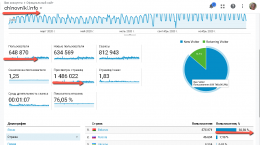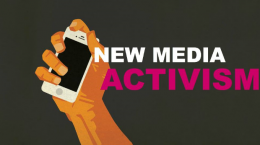Summary: According to Google Analytics and other independent sources, in 2017 “Our House” has reached through its online platforms more than 1 million people in Belarus. Importantly, that was a result of a careful outreach strategy that engaged mostly the non-random audience: the audience that is “Our House” content oriented.
In this report we would like to demonstrate that there are many opportunities to influence and shape the public opinion and socio-political processes for independent players of civil society in nowadays Belarus. This is just the first part of the larger report presenting the results of the work of “Our House”: as it is impossible to cover everything in one report without making it too long and “heavy”.
Despite the numbers we are about to present are flattering, we believe that the potential of these platforms has not yet been used: theoretically these results can be improved at least by 30%. In other words, there is still a room for improvement and development.
We thank all our partners who helped us in 2017 to develop these platforms, and hope very much to continue our close cooperation in 2018.
We also will be glad to new partners, new friends and new cooperation for developing tools to influence the public opinion of various target groups in Belarus.
Let us create our success stories and results together for the sake of a democratic, transparent and prosperous Belarus.
In view of the fact that the volume of the document does not allow us to take screenshots of all the figures indicated in the report, we invite all to request additional information, including screenshots and data of independent meters on the items of interest. We can prove every figure in this report and it would be our pleasure to do this for you.
The website chinovniki.info: Democratic Audit through Popular Control of the Government in Belarus
Many scholars of democracy see popular control as one of the most essential conditions for the stable and effective democracy. Some even argue that ‘governance without accountability is tyranny”.[1] Not many ideas were as crucial and persistent in the history of political thought and action as this one. Indeed popular control is not only an essential idea; it is used as both a symbol of democracy and a marker of separating democracy from non-democratic forms of government.
The purpose of popular control over government is to make sure that that the process of governing (for example, leadership, organization, decision-making, etc.) is in line with the shared ideals of the governed, as well as with the key democratic principles. It is important to note that the purpose of popular control is to regulate the usage of power, not to obtain power per se.
We see citizens’ control over decision-making in connection to the idea of democratic audit, where the former is both a means to and a result of the latter. As Democratic Audit UK project puts it: “It [democratic audit] is a kind of ‘health check’ on the state of a country’s democracy” and is based on “comprehensive and systematic assessment of a country’s political life against the key democratic principles of popular control”.[2]
Thus, in the light of the above-said, the main goal of the website chinovniki.info is to (re)create and to (re)activate mechanisms of democratic audit and of popular control over public and civil servants in Belarus. In order to achieve this goal the team of the website sets up a task to develop a comprehensive database of public and civil servants.
Effectively, the database is a people’s Wikipedia only in the area of work of Belarus’s state officials. Metaphors aside, this database is a tool for popular control over the state authorities as it allows monitoring and following up the activity of concrete state officials (without any personal data). The database includes a list of public and civil servants by location and the area of expertise, their profiles, as well as cases of violations of human rights by them supported by such documents as official reports, citizens’ complaints, official correspondence, etc. The platform is also an education platform for citizens; it provides templates and tips on how to use existing mechanisms to protect own rights.
The statistics of operation of the website chinovniki.info in 2017:
- Currently, there are 96,510 names of civil servants in the database. A year ago in 2016, there were 70,276 civil servants in the database. Thus, the number of officials in the database for 2017 increased by 26,234
- Currently, there are 910 public organizations in the database. A year ago, in 2016, there were 110,821 state organizations in the database. Thus, the number of state organizations for 2017 increased by 3.089 organizations, mainly electoral commissions.
- During the year, 267,970 unique users who viewed 950,346 pages visited the site, which, in our view, indicates that the website has a great relevance. On average, one visitor viewed almost 3 official profiles. In 2016, 263,554 users who viewed 697,003 pages of the site visited the website. The growth in the number of pages viewed by one visitor grew by 26%, which indicates an increase in the site’s capacity and its interest to users.
- 89% of the website visitors are from Belarus. 07% of users are from Russia.
- Most visitors are from Minsk. Their number constitutes 36%; Grodno is the second on attendance rate with 11.26% of visitors. The third on attendance rate is Gomel with 10.84% of overall users.
- 9% of users find the website through search engines, by typing a name of official or a name of the organization. 7.2% of users enter the website directly. The potential, which has not yet been used, is the potential of social networks. Unfortunately, only 1% of users come from there.
Conclusions:
- Users who are looking for information in a more intentional way increasingly use the website. The number of site users has increased, but slightly, by 4,416 users per year (this is a 2% increase in the site visitors). However, in comparison with 2016, the quantity of pages, which they have read on the site, has grown by 26%. That is, on average, one user reads 26% more pages than last year, which, in our opinion, indicates an increase in the site’s capacity and its relevance to users. That is indicative of a shift to a more ‘qualitative’ nature of the audience as opposed to a ‘random’ one.
- 90% of users come to the site through search engines, in search for information about this or that official or organization, which indicates the relevance of the site for ordinary Belarusians. Today, the challenge for the site: make it an even more convenient tool for use by ordinary people, as well as an instrument of influence on public servants in Belarus. The experience of the web-page shows that officials closely monitor information on the web-site and try to respond quicker and more positively to citizens’ appeals if it is suspected that this correspondence will then be sent to the web-site chinovniki.info as a case.
- The greatest challenge of the web-site chinovniki.info for today is to use its potential as a social network for the youth.
- This web-site is public; it is composed of the information from open and accessible sources, very often from websites of executive committees and state organizations. The difference of our web-site from the web-site of other organizations is that chinovniki.info allows seeing the management system of the country: by collecting everything in one place it makes it possible to see the main trends and principles on which decisions are made in the system of state authority of Belarus.
YouTube-channel of “Our House” as a means of promoting ideas among the general population of Belarus
YouTube-channel of “Our House” [3] is a mass information platform of the International Center for Civic Initiative “Our House”; the channel is a partner of YouTube (this means that YouTube pays per views). At the moment, the number of views is 967.428, and the viewing time is more than 2 million 343 thousand 260 minutes (this is almost 40 thousand hours / 1,627 days / 4.5 years)
People from Belarus has watched “Our House” 1 million 668 thousand 42 minutes, from Russia – 366 thousand 606 minutes, from Ukraine – 136 thousand 357 minutes.
In 2017, 33 videos and webinars were produced, and up-to-date there are 179 videos in total.
In 2017, YouTube users watched our YouTube-channel 237,484 times and spent 982,220 minutes on it. 80% of them is the number of users from Belarus, and 9% of users are from Russia.
69.6% of the audience of “Our House” YouTube channel are men and 30.40% are women.
Our channel is the most popular among three age groups: 18-24 years old makes 18% of the total number of YouTube channel audience, 25-34 years old – 41%, 35-44 years old – 22%.
Our channel is the least popular among teenagers: 13-17 years old – 2.5%, and among people of pre-retirement and retirement age: 45-54 years old – 8.5%, 55-64 years old – 5.1%, 65+ years old- 2.9%.
YouTube has paid 561.90 euros in total to “Our House” for views in 2017.
Conclusions:
- The YouTube channel is an accessible and mass information platform for NGOs and any non-state initiative that allows them to disseminate their views to a huge audience of YouTube users. The YouTube channel of “Our House” has a steady progress in building communication with its target audience.
- In 2017, the number of those who watched our channel decreased by 26% compared to 2016. However, this is very important that at the same time, the number of minutes of views increased by 33% for the year. That is, users came to the YouTube channel on purpose and stayed there to watch the video until the end. This suggests that the audience of “Our House” on the YouTube channel is becoming more motivated and less ‘random’: users know why they are going to the channel of “Our House” and are not getting there by accident (a random user after a couple of seconds will close the video and this will affect the statistics of the minutes of views).
- The number of minutes of viewing one video increased: in 2016, one video was watched at about 2 minutes on average; in 2017, one video was watched – more than 4 minutes, which means that the person watched the video for a long time, until the end, i.e. they were interesting to him/her.
- The number of regular subscribers of the channel increased by 47% compared to 2016, and the number of “likes” of different videos increased by 62% in 2017 compared to 2016.
- In addition, the number of users who shared a video from YouTube channel of “Our House” on social networks increased by 52% compared to 2016.
- It is important to note that the majority of users are people from Belarus, that is, YouTube channel of “Our House” disseminates its ideas to the people of Belarus.
- “Our House” needs to think more carefully how to attract more women and pensioners to its channel, without losing the old subscribers in 2018.
The website of “Our House”: results
- The number of unique users who visited the website of “Our House”.
The number of unique users who visited the site of “Our House” was 103.420 visitors who read 245.856 pages. The average amount of time that one user spent on our website was 1 minute 37 seconds.77.52% of users are from Belarus. 11.86% are from Russia. 2.41% of users are from Ukraine.For comparison: for the same period in 2016, 77,634 unique users who viewed 182,194 pages visited the website. The number of users from Belarus was 74.55%, the number of users from Russia – 10.56%, the number of users from Ukraine – 3.38%. - The number of unique visitors who read the website of “Our House” using mobile applications in Google Newsstand.
OH became Belarus’ first and the last CSO to receive Google Newsstand registration.The number of unique visitors who read the site of “Our House” using mobile applications amounted to 7,027 individuals in 2017, who had read 62,345 pages on the website.For comparison: for the same period in 2016, the number of unique users who read the site of “Our House” using mobile applications was 4.090 individuals, they had read 34.254 pages. - The number of written articles on the website of “Our House”.
In 2017, 648 articles were published on the website of “Our House”. This is an average of 2.5 articles per day during the working hours.For comparison: for the same period in 2016, 520 articles were written and published on the website. This is slightly less than 2 articles per day during the working hours.
Conclusion:
- The number of visitors of the wsite of “Our House” increased by 25% in 2017, the number of pages viewed by users increased by 26% compared to 2016, which, in our opinion, indicates the growing interest of the population in what “Our House” does.
- The number of readers attending the website of “Our House” through mobile applications in 2017 increased by 42%, and the number of pages viewed increased by 45%.
- The number of written articles on the web-site increased by 20% in 2017, which also demonstrates the growth in activity of “Our House”.
Google Books: the sustainability in the use and dissemination of information material of “Our House”.
“Our House” has its own account in the Google Books. “Our House” downloads all books and leaflets produced by the organization as a part of our social and political activity on the Google Books. The Google Books account of “Our House” is very popular among users. In January-December 2017, readers downloaded the products of “Our House” 305.151 times that indicates the relevance and necessity of our information products for people. For example, the coloring book for children “A Member of Local Council of my Dream” was downloaded more than 15.408 times. The calendar with female political prisoners was downloaded 17.374 times. Whereas the book of “Children of war” was downloaded more than 81.235 times and the book of “Political jokes of Belarus”, composed by “Our House”, was downloaded more than 182.424 times.
Conclusions:
- The presence of the Google Books account of “Our House” makes the release of any information products of the organization sustainable, because it becomes available on the account and any user who has a bankcard can download it. All products of “Our House” are distributed free of charge, nevertheless, this account allows widely distribute it even when the project of the organization has already ended.
- This is a new and simple channel (and most importantly, it is free) of mass distribution of its information products. It is available in Belarus and is not blocked by the state. Distribution of information products of “Our House” through this account does not require additional resources; nevertheless, other NGOs of Belarus do not use such an opportunity to distribute their information products, for some reason.
- The use of such innovative platforms allows any NGO seriously expand its audience and reach (attract) new people and new social groups that were not involved earlier.
[1] Borowiak, Craig T. Accountability and Democracy: The Pitfalls and Promise of Popular Control. Oxford University Press, 2011.







